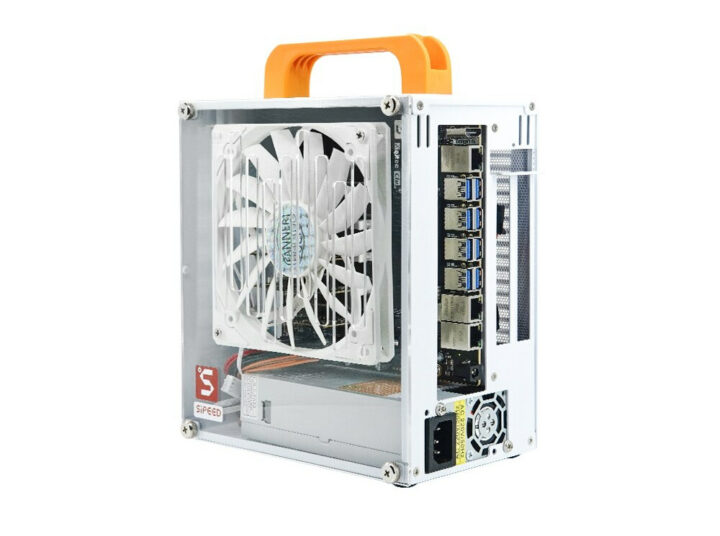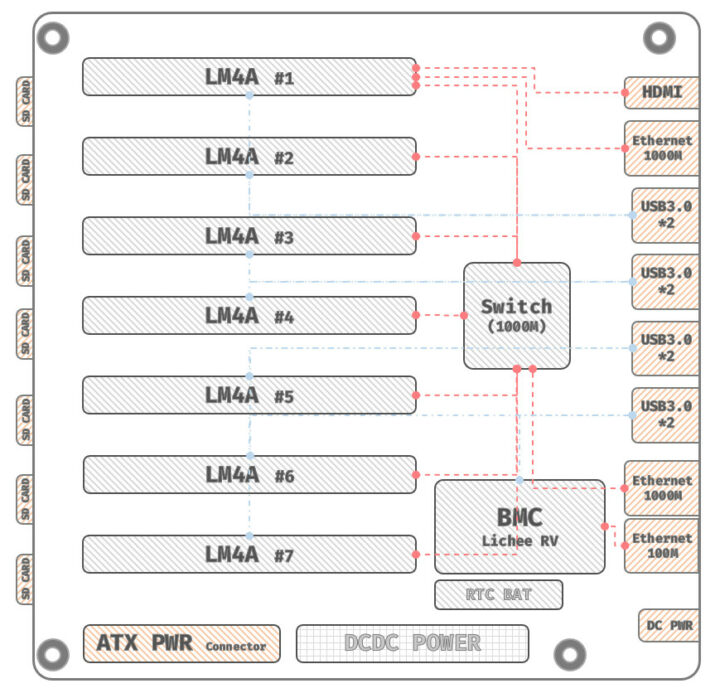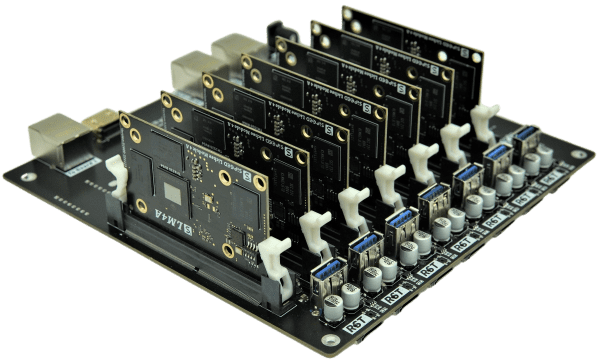As expected, Sipeed has now launched their Lichee Cluster 4A mini-ITX cluster board and box taking up to seven RISC-V modules with prices starting at $929 on Aliexpress.
All kits on offer are fitted with seven Sipeed LM4A system-on-modules based on the T-Head TH1520 quad-core RISC-V processor in either 8GB/32GB or 16GB/128GB memory and storage configuration.
Lichee Cluster 4A specifications:
- SoM – 7x Sipeed LM4A modules with Alibaba T-Head TH1520 processor (4x C910 @ 1.85GHz) and a total of either 56 or 112GB LPDDR4X, and 224GB or 869GB eMMC flash
- Storage – 7x microSD card slots, one per slot
- Video Output – 1x HDMI port connected to slot 1
- Networking
- 1x Gigabit Ethernet port for the cluster
- 1x Gigabit Ethernet port for slot 1 only
- 1x Ethernet for BMC control
- USB
- 7x USB 3.0 ports, one per slot
- 1x USB 2.0 port for BMC
- Power Supply – 12V DC input or 1U Power Module; At least 60W, recommended >= 90W
- Dimensions
- Motherboard 17 x 17 cm (Mini-ITX form factor)
- Box – 20 x 12 x 22 cm

All configurations ship with Debian with distcc and Zabbix pre-installed for demonstration. A Linux 6.4 kernel build is said to take 15 minutes with seven modules and native RISC-V development is the main target application of this system.
The wiki specific to the cluster board has yet to be translated into English, so for now, you’ll find the documentation in Chinese only. The documentation for the LM4A SoM has already been translated into English since the RISC-V CPU module has been available for a little longer.

Four different configurations are offered on Aliexpress:
- $929 for a mini-ITX cluster board with 7x LM4A RISC-V module in 8GB/32GB configuration
- $1,239 for a mini-ITX cluster board with 7x LM4A RISC-V module in 16GB/128GB configuration
- $965 for a cluster box with seven 8GB/32GB modules
- $1,288 for a cluster box with seven 16GB/128GB modules
You can also purchase the modules individually for $108 (8GB/32GB) and $155 (16GB/128GB) respectively. But note that only the cluster boxes are in stock at the time of writing and prices don’t include shipping and potential taxes.
Via Liliputing

Jean-Luc started CNX Software in 2010 as a part-time endeavor, before quitting his job as a software engineering manager, and starting to write daily news, and reviews full time later in 2011.
Support CNX Software! Donate via cryptocurrencies, become a Patron on Patreon, or purchase goods on Amazon or Aliexpress






I’m wondering if the 12V jack can realistically be used to power all boards. Even if it would support 10A that would be only 17W peak per board (a bit less once you deduce the BMC and the switch chip). I don’t know if the boards never reach that peak power. It just happens that clusters have a huge tendency to make all nodes consume their peak power at the same time.
Also, I find it a quite sad that the cluster board is still limited to 1 Gbps across all boards. That’s only 140 Mbps per board, it seriously limits the cluster’s usefulness for data processing! Nowadays it’s not difficult to find switch chips supporting higher uplink speeds. Even the ubiquitous 2.5Gbps would have been small yet easily accessible.
Last point, I hope that each board’s reset line (or preferably power supply) is controllable from the BMC. Since there’s little doc, it’s not easy to figure if that’s the case.
I’m using a 20a 12v transformer with my current Mini-ITX board (AMD Ryzen 7 5700G) and I’d think you would want something similar for all these boards and cores.
And it’s happily passing 20A into a barrel connector ? I would have thought the limits were lower, for having burnt a few in the past, but I know there are different categories.